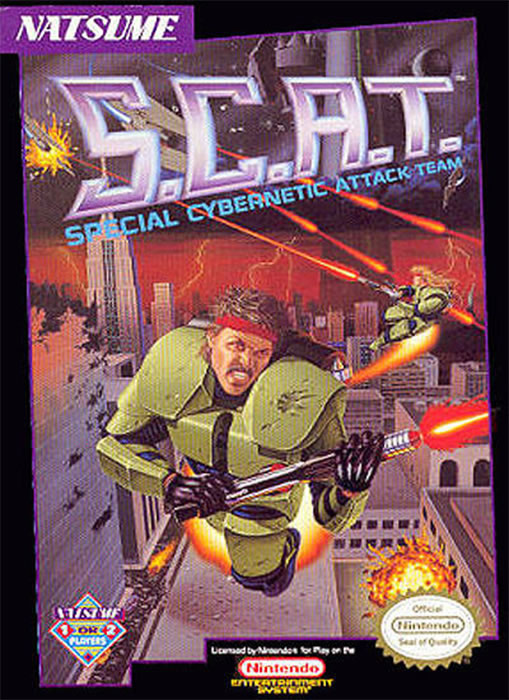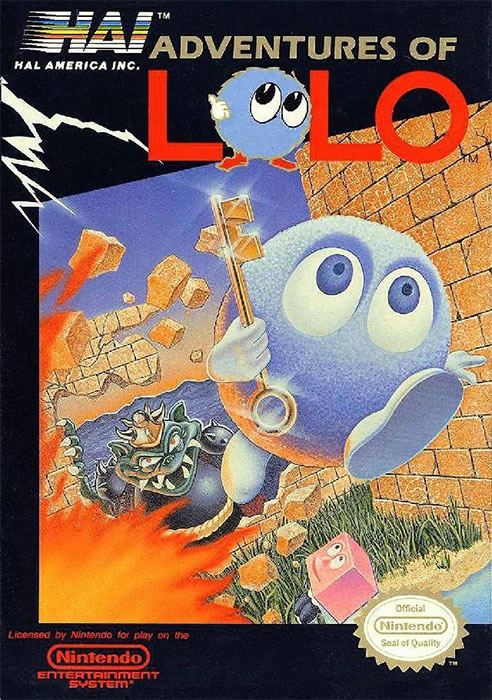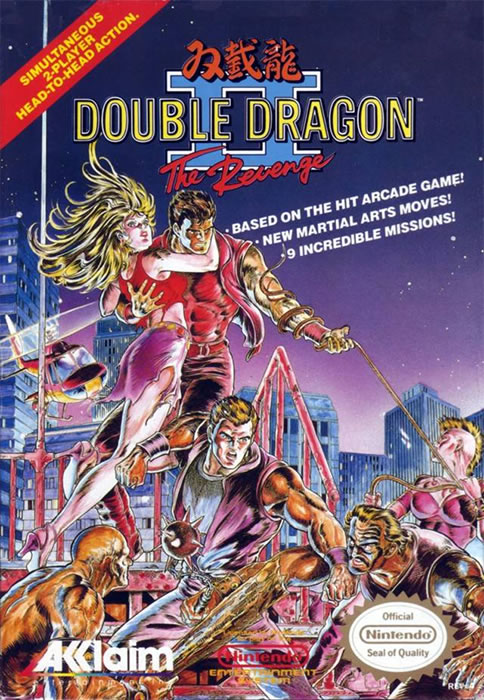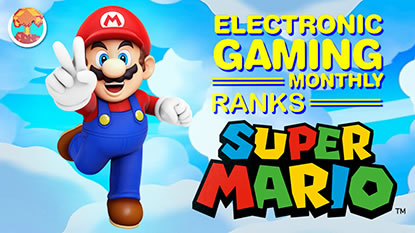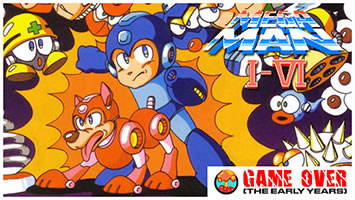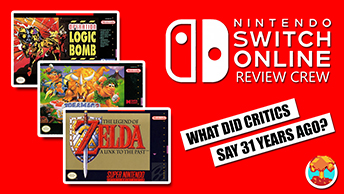- CLASSIC MAGAZINES
- REVIEW CREW
A show recapping what critics thought back
when classic games first came out! - NEXT GENERATION'S BEST & WORST
From the worst 1-star reviews to the best
5-stars can offer, this is Next Generation! - NINTENDO POWER (ARCHIVE)
Experience a variety of shows looking at the
often baffling history of Nintendo Power! - MAGAZINE RETROSPECTIVE
We're looking at the absolutely true history of
some of the most iconic game magazines ever! - SUPER PLAY'S TOP 600
The longest and most ambitious Super NES
countdown on the internet! - THEY SAID WHAT?
Debunking predictions and gossip found
in classic video game magazines! - NEXT GENERATION UNCOVERED
Cyril is back in this spin-off series, featuring the
cover critic review the art of Next Generation! - HARDCORE GAMER MAGAZING (PDF ISSUES)
Download all 36 issues of Hardcore Gamer
Magazine and relive the fun in PDF form!
- REVIEW CREW
- ELECTRONIC GAMING MONTHLY
- ELECTRONIC GAMING MONTHLY RANKS
From Mario to Sonic to Street Fighter, EGM
ranks classic game franchises and consoles! - ELECTRONIC GAMING MONTHLY BEST & WORST
Counting down EGM’s best and worst reviews
going year by year, from 1989 – 2009! - ELECTRONIC GAMING BEST & WORST AWARDS
11-part video series chronicling the ups and
downs of EGM’s Best & Worst Awards!
- ELECTRONIC GAMING MONTHLY RANKS
- GAME HISTORY
- GAME OVER: STORY BREAKDOWNS
Long-running series breaking down game
stories and analyzing their endings! - A BRIEF HISTORY OF GAMING w/ [NAME HERE]
Real history presented in a fun and pithy
format from a variety of game historians! - THE BLACK SHEEP
A series looking back at the black sheep
entries in popular game franchises! - INSTANT EXPERT
Everything you could possibly want to know
about a wide variety of gaming topics! - FREEZE FRAME
When something familiar happens in the games
industry, we're there to take a picture! - I'VE GOT YOUR NUMBER
Learn real video game history through a series
of number-themed episodes, starting at zero! - GREAT MOMENTS IN BAD ACTING
A joyous celebration of some of gaming's
absolute worst voice acting!
- GAME OVER: STORY BREAKDOWNS
- POPULAR SHOWS
- DG NEWS w/ LORNE RISELEY
Newsman Lorne Riseley hosts a regular
series looking at the hottest gaming news! - REVIEW REWIND
Cyril replays a game he reviewed 10+ years
ago to see if he got it right or wrong! - ON-RUNNING FEUDS
Defunct Games' longest-running show, with
editorials, observations and other fun oddities! - DEFUNCT GAMES QUIZ (ARCHIVE)
From online quizzes to game shows, we're
putting your video game knowledge to the test!- QUIZ: ONLINE PASS
Take a weekly quiz to see how well you know
the news and current gaming events! - QUIZ: KNOW THE GAME
One-on-one quiz show where contestants
find out if they actually know classic games! - QUIZ: THE LEADERBOARD
Can you guess the game based on the classic
review? Find out with The Leaderboard!
- QUIZ: ONLINE PASS
- DEFUNCT GAMES VS.
Cyril and the Defunct Games staff isn't afraid
to choose their favorite games and more! - CYRIL READS WORLDS OF POWER
Defunct Games recreates classic game
novelizations through the audio book format!
- DG NEWS w/ LORNE RISELEY
- COMEDY
- GAME EXPECTANCY
How long will your favorite hero live? We crunch
the numbers in this series about dying! - VIDEO GAME ADVICE
Famous game characters answer real personal
advice questions with a humorous slant! - FAKE GAMES: GUERILLA SCRAPBOOK
A long-running series about fake games and
the people who love them (covers included)! - WORST GAME EVER
A contest that attempts to create the worst
video game ever made, complete with covers! - LEVEL 1 STORIES
Literature based on the first stages of some
of your favorite classic video games! - THE COVER CRITIC
One of Defunct Games' earliest shows, Cover
Critic digs up some of the worst box art ever! - COMMERCIAL BREAK
Take a trip through some of the best and
worst video game advertisements of all time! - COMIC BOOK MODS
You've never seen comics like this before.
A curious mix of rewritten video game comics!
- GAME EXPECTANCY
- SERIES ARCHIVE
- NINTENDO SWITCH ONLINE ARCHIVE
A regularly-updated list of every Nintendo
Switch Online release, plus links to review! - PLAYSTATION PLUS CLASSIC ARCHIVE
A comprehensive list of every PlayStation
Plus classic release, including links! - RETRO-BIT PUBLISHING ARCHIVE
A regularly-updated list of every Retro-Bit
game released! - REVIEW MARATHONS w/ ADAM WALLACE
Join critic Adam Wallace as he takes us on a
classic review marathon with different themes!- DEFUNCT GAMES GOLF CLUB
Adam Wallace takes to the links to slice his way
through 72 classic golf game reviews! - 007 IN PIXELS
Adam Wallace takes on the world's greatest spy
as he reviews 15 weeks of James Bond games! - A SALUTE TO VAMPIRES
Adam Wallace is sinking his teeth into a series
covering Castlevania, BloodRayne and more! - CAPCOM'S CURSE
Adam Wallace is celebrating 13 days of Halloween
with a line-up of Capcom's scariest games! - THE FALL OF SUPERMAN
Adam Wallace is a man of steel for playing
some of the absolute worst Superman games! - THE 31 GAMES OF HALLOWEEN
Adam Wallace spends every day of October afraid
as he reviews some of the scariest games ever! - 12 WEEKS OF STAR TREK
Adam Wallace boldly goes where no critic has
gone before in this Star Trek marathon!
- DEFUNCT GAMES GOLF CLUB
- DAYS OF CHRISTMAS (ARCHIVE)
Annual holiday series with themed-episodes
that date all the way back to 2001!- 2015: 30 Ridiculous Retro Rumors
- 2014: 29 Magazines of Christmas
- 2013: 29 Questionable Power-Ups of Christmas
- 2012: 34 Theme Songs of Christmas
- 2011: 32 Game Endings of Christmas
- 2010: 31 Bonus Levels of Christmas
- 2009: 30 Genres of Christmas
- 2008: 29 Controls of Christmas
- 2007: 34 Cliches of Christmas
- 2006: 33 Consoles of Christmas
- 2005: 32 Articles of Christmas
- 2004: 31 Websites of Christmas
- 2003: 29 Issues of Christmas
- 2002: 28 Years of Christmas
- 2001: 33 Days of Christmas
- NINTENDO SWITCH ONLINE ARCHIVE
- REVIEW ARCHIVE
- FULL ARCHIVE
Nintendo Switch Online: 1980s Critics Review Double Dragon II, S.C.A.T. & Adventures of Lolo
The game you're looking at right now is S.C.A.T.: Special Cybernetic Attack Team, and not only is it one of the many games on the Nintendo Switch Online service, but it's one of the many games that I have not covered on the Nintendo Switch Online Review Crew. This summer, we're going to fill in the classic Nintendo Entertainment System and Super NES games we missed, including Adventures of Lolo, the aforementioned S.C.A.T., and Double Dragon II: The Revenge. These three games were added to Nintendo's online service years ago, but the question still remains: Are any of them worth playing? To answer that question, I decided to flip through the pages of Electronic Gaming Monthly, Video Games & Computer Entertainment, Mean Machines and more classic magazines to see what the critics said back when these games first came out. So, go and grab your jetpack, because we're going to be moving some blocks in this vengeful episode of Nintendo Switch Online Review Crew.
Although we talk a lot about the shoot ‘em ups of the 1980s and 90s, these tend to be the 16-bit hits that made waves on the Genesis and Super NES. However, there were a few shooters for the 8-bit Nintendo Entertainment System that somehow managed to overcome the hardware limitations and become either must-play hits or well-regarded cult classics. That's certainly true of the unfortunately-named S.C.A.T.: Special Cybernetic Attack Team, a game set in the distant future of 2029 where heroes Arnold and Sigourney use jetpacks to fly around the screen shooting down aliens and liberating New York City and the rest of the world. In other words, it's Natsume's version of Forgotten Worlds, only with 8-bit graphics and a female co-lead.
When it comes to the reviews, the critics were mostly on the side of S.C.A.T. Electronic Gaming Monthly, for example, gave the game an average score of 7.5 out of 10 and praised what it was able to do on the NES. Ed noted that “Long, hard and intense shooters don't come along very often. The graphics are exceptional and comes off very well on the NES. Smooth scrolling and great gameplay help make this better than average. I like it.” Steve also liked it, but was frustrated by the hardware limitations: “S.C.A.T. takes the basic theme from Forgotten Worlds and throws it onto the NES. The action is intense, and the game only suffers from a lack of visual clarity caused by some flicker when too much is going on.”
I imagine that these technical issues were what led Nintendo Power to give the game a 3.1 out of 5, though they weren't really clear on their criticisms. GamePro, on the other hand, went as high as a 4 out of 5, raving about the world building. This is in line with the 8 out of 10 S.C.A.T. got from Video Games & Computer Entertainment, who concluded that it “obviously has some familiar features about it, but is nonetheless a well-crafted and enjoyable game. The graphics are interesting, with variable scrolling and little flicker. The soundtrack is equally good throughout – explosions, music and all. All in all, it's a fun game that should be given a look.” I agree, so check it out on Nintendo Switch Online if you haven't already.
When you think puzzle games on the Nintendo Entertainment System, you probably picture falling blocks or vitamin capsules. Sure, games like Tetris and Dr. Mario may have taking up a lot of the oxygen, but my good friend Lolo is here to remind you that there was more than one type of 8-bit puzzle game. Adventures of Lolo is a fun overhead puzzler that sees you trying to move blocks in order to traverse the colorful world and avoid the many enemies wandering around. The formula was so much fun that HAL Laboratory ended up making two more sequels, making Adventures of Lolo one of the best and most consistent trilogies on the NES.
The critics liked it, though the way they chose to show it was ... interesting. A good example of that is Ed at Electronic Gaming Monthly, who starts his review by saying, “I feel sorry for this game. It is similar to Soloman's Key, a challenging combination of action strategy. Lolo requires experimenting, through trial and error, to find the correct pattern for each level. Kiddie graphics disguise a game that is for all ages and filled with countless hours of enjoyment.” Jim agreed, praising it as a “good thinking game with nice graphics and sounds. It's not unbeatable, despite the number of rooms that must be overcome. This one's a good change of pace if you're sick of shooters and want an alternative to Legend of Zelda.” Electronic Gaming Monthly ended up giving Lolo an average score of 7.5 out of 10.
That's not that far off from the 3.5 out of 5 you saw coming from Nintendo Power. Nintendo Magazine System also landed in that range, giving it a 74% and calling it an “intriguing puzzle game which certainly packs a challenge but doesn't feature much in the way of action or variety. Definitely one for those who like the pace of their games sedate.” In other words, it's not a shoot ‘em up. It's weird how the critics keep harping on a puzzle game for not having more action. Check the game out on Nintendo Switch Online and see if you agree with that criticism, because I certainly don't.
The original Double Dragon is, without a doubt, one of the most influential arcade games of all time. That said, I would argue that the Nintendo Entertainment System sequel, Double Dragon II: The Revenge, is a substantially better game. It tells a cinematic story that is spread across a number of incredibly creative stages, all designed to push the Nintendo Entertainment System to the limits. And it works, because this is, at least in my opinion, the franchise's high-water mark. But let's see if the critics agree with my full-throated endorsement of Double Dragon II.
Based on the reviews over at Electronic Gaming Monthly, the critics definitely agreed with me. Ed called it “every bit as good, and even better, than the first. It's all new too! New moves, new scenes, great graphics, excellent player control and multiple difficulty levels. Double Dragon 2 is easily the best kick-and-punch game ever made.” Once again, Jim is here to back Ed up: “Double Dragon 2 represents a phenomenal improvement over the original Double Dragon. The graphics, gameplay and two-player interaction all combine to blow Double Dragon out of my NES.” EGM gave this sequel an average score of 8 out of 10.
On the other side of the coin you have Video Games & Computer Entertainment, which gave Double Dragon II the lowest score I could find, a 6 out of 10. “If at first you succeed ... do a sequel. This seems to have been the motto of moviemakers and, more recently, of gamemakers. Double Dragon II is the sequel to Double Dragon. It retains the strong points of the original, but improves on it in many ways. It is, to my way of thinking, a successful sequel.” That said, they ended up complaining about the challenging stages and the frustrating obstacles that lead to deaths that are outside of your control.
Across the pond, you saw Double Dragon II: The Revenge earn high scores from the British critics. For example, Nintendo Magazine System ended up going as high as an 84%. Mean Machines, on the other hand, went with an 80% and gave it a high recommendation. Julian argued that “although Double Dragon II looks a bit rough around the edges, it's great fun to play. The multitude of baddies to bash and the sheer variety of backdrops and weapons make this one stand head and shoulders above most Nintendo beat ‘em ups.” I absolutely agree. This is definitely one of the best 8-bit brawlers, and is leagues better than the Genesis and arcade sequels. Give it a play.
| Publication | Scores |
|---|---|
| Video Games & Computer Entertainment | 8/10 |
| GamePro | 4/5 |
| Electronic Gaming Monthly | 7.5/10 |
| Nintendo Power | 3.1/5 |
| AVERAGE SCORE | 74% |
When it comes to the reviews, the critics were mostly on the side of S.C.A.T. Electronic Gaming Monthly, for example, gave the game an average score of 7.5 out of 10 and praised what it was able to do on the NES. Ed noted that “Long, hard and intense shooters don't come along very often. The graphics are exceptional and comes off very well on the NES. Smooth scrolling and great gameplay help make this better than average. I like it.” Steve also liked it, but was frustrated by the hardware limitations: “S.C.A.T. takes the basic theme from Forgotten Worlds and throws it onto the NES. The action is intense, and the game only suffers from a lack of visual clarity caused by some flicker when too much is going on.”
I imagine that these technical issues were what led Nintendo Power to give the game a 3.1 out of 5, though they weren't really clear on their criticisms. GamePro, on the other hand, went as high as a 4 out of 5, raving about the world building. This is in line with the 8 out of 10 S.C.A.T. got from Video Games & Computer Entertainment, who concluded that it “obviously has some familiar features about it, but is nonetheless a well-crafted and enjoyable game. The graphics are interesting, with variable scrolling and little flicker. The soundtrack is equally good throughout – explosions, music and all. All in all, it's a fun game that should be given a look.” I agree, so check it out on Nintendo Switch Online if you haven't already.
| Publication | Scores |
|---|---|
| Electronic Gaming Monthly | 7.5/10 |
| Nintendo Magazine System | 74% |
| Nintendo Power | 3.5/5 |
| AVERAGE SCORE | 73% |
The critics liked it, though the way they chose to show it was ... interesting. A good example of that is Ed at Electronic Gaming Monthly, who starts his review by saying, “I feel sorry for this game. It is similar to Soloman's Key, a challenging combination of action strategy. Lolo requires experimenting, through trial and error, to find the correct pattern for each level. Kiddie graphics disguise a game that is for all ages and filled with countless hours of enjoyment.” Jim agreed, praising it as a “good thinking game with nice graphics and sounds. It's not unbeatable, despite the number of rooms that must be overcome. This one's a good change of pace if you're sick of shooters and want an alternative to Legend of Zelda.” Electronic Gaming Monthly ended up giving Lolo an average score of 7.5 out of 10.
That's not that far off from the 3.5 out of 5 you saw coming from Nintendo Power. Nintendo Magazine System also landed in that range, giving it a 74% and calling it an “intriguing puzzle game which certainly packs a challenge but doesn't feature much in the way of action or variety. Definitely one for those who like the pace of their games sedate.” In other words, it's not a shoot ‘em up. It's weird how the critics keep harping on a puzzle game for not having more action. Check the game out on Nintendo Switch Online and see if you agree with that criticism, because I certainly don't.
| Publication | Scores |
|---|---|
| Nintendo Magazine System | 84% |
| Mean Machines | 83% |
| Electronic Gaming Monthly | 8/10 |
| Video Games & Computer Entertainment | 6/10 |
| AVERAGE SCORE | 77% |
Based on the reviews over at Electronic Gaming Monthly, the critics definitely agreed with me. Ed called it “every bit as good, and even better, than the first. It's all new too! New moves, new scenes, great graphics, excellent player control and multiple difficulty levels. Double Dragon 2 is easily the best kick-and-punch game ever made.” Once again, Jim is here to back Ed up: “Double Dragon 2 represents a phenomenal improvement over the original Double Dragon. The graphics, gameplay and two-player interaction all combine to blow Double Dragon out of my NES.” EGM gave this sequel an average score of 8 out of 10.
On the other side of the coin you have Video Games & Computer Entertainment, which gave Double Dragon II the lowest score I could find, a 6 out of 10. “If at first you succeed ... do a sequel. This seems to have been the motto of moviemakers and, more recently, of gamemakers. Double Dragon II is the sequel to Double Dragon. It retains the strong points of the original, but improves on it in many ways. It is, to my way of thinking, a successful sequel.” That said, they ended up complaining about the challenging stages and the frustrating obstacles that lead to deaths that are outside of your control.
Across the pond, you saw Double Dragon II: The Revenge earn high scores from the British critics. For example, Nintendo Magazine System ended up going as high as an 84%. Mean Machines, on the other hand, went with an 80% and gave it a high recommendation. Julian argued that “although Double Dragon II looks a bit rough around the edges, it's great fun to play. The multitude of baddies to bash and the sheer variety of backdrops and weapons make this one stand head and shoulders above most Nintendo beat ‘em ups.” I absolutely agree. This is definitely one of the best 8-bit brawlers, and is leagues better than the Genesis and arcade sequels. Give it a play.
HOME |
CONTACT |
NOW HIRING |
WHAT IS DEFUNCT GAMES? |
NINTENDO SWITCH ONLINE |
RETRO-BIT PUBLISHING
Retro-Bit |
Switch Planet |
The Halcyon Show |
Same Name, Different Game |
Dragnix |
Press the Buttons
Game Zone Online | Hardcore Gamer | The Dreamcast Junkyard | Video Game Blogger
Dr Strife | Games For Lunch | Mondo Cool Cast | Boxed Pixels | Sega CD Universe | Gaming Trend
Game Zone Online | Hardcore Gamer | The Dreamcast Junkyard | Video Game Blogger
Dr Strife | Games For Lunch | Mondo Cool Cast | Boxed Pixels | Sega CD Universe | Gaming Trend
Copyright © 2001-2025 Defunct Games
All rights reserved. All trademarks are properties of their respective owners.
All rights reserved. All trademarks are properties of their respective owners.







